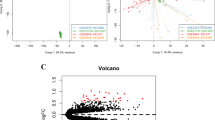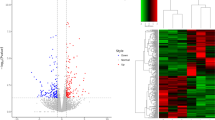Abstract
Purpose
This study aimed to identify associated genes with primary open-angle glaucoma (POAG) and explore the potentially modular mechanism underlying POAG.
Methods
We downloaded gene expression profiles data GSE27276 from gene expression omnibus and identified differentially expressed genes between POAG patients and normal controls. Then, gene ontology analysis and kyoto encyclopedia of genes and genomes pathway enrichment were performed to predict the DEGs functions, followed with the construction, centrality analysis, and module mining of protein–protein interaction network.
Results
A total of 552 DEGs including 249 up-regulated and 303 down-regulated genes were identified. The up-regulated DEGs were significantly involved in cell adhesion molecule, while the down-regulated DEGs were significantly involved in complement and coagulation cascades. Centrality analysis screened out 20 genes, among which COL4A4, COL3A1, COL1A2, ITGB5, COL5A2, and COL5A1 were shared in ECM–receptor interaction and focal adhesion pathways. In the sub-network, COL5A2, COL8A2, and COL5A1 were significantly enriched in biological function of eye morphogenesis and eye development, while LAMA5, COL3A1, COL1A2, and COL5A1 were significantly enriched in vasculature development and blood vessel development.
Conclusions
Six genes, including COL4A4, COL3A1, COL1A2, ITGB5, COL5A2, and COL5A1, ECM–receptor interaction and focal adhesion pathway, are potentially involved in the pathogenesis of POAG via participating in pathways of ECM–receptor interaction and focal adhesion.





Similar content being viewed by others
References
Quigley HA, Broman AT (2006) The number of people with glaucoma worldwide in 2010 and 2020. Br J Ophthalmol 90(3):262–267
Weinreb RN, Khaw PT (2004) Primary open-angle glaucoma. Lancet 363(9422):1711–1720. doi:10.1016/S0140-6736(04)16257-0
Quigley HA (1993) Open-angle glaucoma. N Engl J Med 328(15):1097–1106
Zhou L, Li Y, Yue BY (1998) Glucocorticoid effects on extracellular matrix proteins and integrins in bovine trabecular meshwork cells in relation to glaucoma. Int J Mol Med 1(2):339–346
Rezaie T, Child A, Hitchings R, Brice G, Miller L, Coca-Prados M, Héon E, Krupin T, Ritch R, Kreutzer D (2002) Adult-onset primary open-angle glaucoma caused by mutations in optineurin. Science 295(5557):1077–1079
Kwon YH, Fingert JH, Kuehn MH, Alward WL (2009) Primary open-angle glaucoma. N Engl J Med 360(11):1113–1124
Kass MA, Heuer DK, Higginbotham EJ, Johnson CA, Keltner JL, Miller JP, Parrish RK, Wilson MR, Gordon MO (2002) The ocular hypertension treatment study: a randomized trial determines that topical ocular hypotensive medication delays or prevents the onset of primary open-angle glaucoma. Arch Ophthalmol 120(6):701–713
Pang CP, Leung YF, Fan B, Baum L, Tong WC, Lee WS, Chua JK, Fan DS, Liu Y, Lam DS (2002) TIGR/MYOC gene sequence alterations in individuals with and without primary open-angle glaucoma. Invest Ophthalmol Vis Sci 43(10):3231–3235
Gao X, Gauderman WJ, Liu Y, Marjoram P, Torres M, Haritunians T, Kuo JZ, Chen Y-DI, Allingham RR, Hauser MA (2013) A genome-wide association study of central corneal thickness in Latinos. Invest Ophthalmol Vis Sci 54(4):2435
Thorleifsson G, Walters GB, Hewitt AW, Masson G, Helgason A, DeWan A, Sigurdsson A, Jonasdottir A, Gudjonsson SA, Magnusson KP (2010) Common variants near CAV1 and CAV2 are associated with primary open-angle glaucoma. Nat Genet 42(10):906–909
Fan BJ, Wang DY, Lam DSC, Pang CP (2006) Gene mapping for primary open angle glaucoma. Clin Biochem 39(3):249–258. doi:10.1016/j.clinbiochem.2005.11.001
Liu Y, Allingham RR, Qin X, Layfield D, Dellinger AE, Gibson J, Wheeler J, Ashley-Koch AE, Stamer WD, Hauser MA (2013) Gene expression profile in human trabecular meshwork from patients with primary open-angle glaucoma. Invest Ophthalmol Vis Sci 54(9):6382–6389
Gautier L, Cope L, Bolstad BM, Irizarry RA (2004) Affy—analysis of affymetrix genechip data at the probe level. Bioinformatics 20(3):307–315
Smyth GK (2005) Limma linear models for microarray data. In: Gentleman R, Carey V, Huber W, Irizarry R, Dudoit S (eds) Bioinformatics and computational biology solutions using R and bioconductor. Springer, Berlin, pp 397–420
Hulsegge I, Kommadath A, Smits MA (2009) Globaltest and GOEAST: two different approaches for gene ontology analysis. BMC Proc 3(Suppl 4):S10. doi:10.1186/1753-6561-3-S4-S10
Kanehisa M, Goto S (2000) KEGG: kyoto encyclopedia of genes and genomes. Nucl Acids Res 28(1):27–30
Da Wei Huang BTS, Lempicki RA (2008) Systematic and integrative analysis of large gene lists using DAVID bioinformatics resources. Nat Protoc 4(1):44–57
Szklarczyk D, Franceschini A, Wyder S, Forslund K, Heller D, Huerta-Cepas J, Simonovic M, Roth A, Santos A, Tsafou KP (2014) STRING v10: protein–protein interaction networks, integrated over the tree of life. Nucl Acids Res. doi:10.1093/nar/gku1003
Szklarczyk D, Franceschini A, Kuhn M, Simonovic M, Roth A, Minguez P, Doerks T, Stark M, Muller J, Bork P (2011) The STRING database in 2011: functional interaction networks of proteins, globally integrated and scored. Nucl Acids Res 39(suppl 1):D561–D568
Jeong H, Mason SP, Barabasi AL, Oltvai ZN (2001) Lethality and centrality in protein networks. Nature 411(6833):41–42. doi:10.1038/3507513835075138
Goh KI, Oh E, Kahng B, Kim D (2003) Betweenness centrality correlation in social networks. Phys Rev E 67(1 Pt 2):017101
Estrada E, Rodriguez-Velazquez JA (2005) Subgraph centrality in complex networks. Phys Rev E 71(5 Pt 2):056103
Nepusz T, Yu H, Paccanaro A (2012) Detecting overlapping protein complexes in protein-protein interaction networks. Nat Methods 9(5):471–472
Prockop DJ, Kivirikko KI (1995) Collagens: molecular biology, diseases, and potentials for therapy. Annu Rev Biochem 64:403–434
Mk G, Ra H (2010) Collagens. Cell Tissue Res 339:247–257
Segev F, Heon E, Cole WG, Wenstrup RJ, Young F, Slomovic AR, Rootman DS, Whitaker-Menezes D, Chervoneva I, Birk DE (2006) Structural abnormalities of the cornea and lid resulting from collagen V mutations. Investig Ophthalmol Vis Sci 47(2):565–573
Vitart V, Bencic G, Hayward C, Skunca Herman J, Huffman J, Campbell S, Bucan K, Navarro P, Gunjaca G, Marin J, Zgaga L, Kolcic I, Polasek O, Kirin M, Hastie ND, Wilson JF, Rudan I, Campbell H, Vatavuk Z, Fleck B, Wright A (2010) New loci associated with central cornea thickness include COL5A1, AKAP13 and AVGR8. Hum Mol Genet 19(21):4304–4311
Vithana EN, Aung T, Khor CC, Cornes BK, Tay WT, Sim X, Lavanya R, Wu R, Zheng Y, Hibberd ML, Chia KS, Seielstad M, Goh LK, Saw SM, Tai ES, Wong TY (2011) Collagen-related genes influence the glaucoma risk factor, central corneal thickness. Hum Mol Genet 20(4):649–658
Lobler M, Buss D, Kastner C, Mostertz J, Homuth G, Ernst M, Guthoff R, Wree A, Stahnke T, Fuellen G, Voelker U, Schmitz KP (2013) Ocular fibroblast types differ in their mRNA profiles—implications for fibrosis prevention after aqueous shunt implantation. Mol Vis 19:1321–1331
Rosado C, Bueno E, Felipe C (2014) COL4A4 gene study of a European population: description of new mutations causing autosomal dominant Alport syndrome. Int J Mol Epidemiol Genet 5(4):177–184
Wu Y, Singh S, Georgescu MM, Birge RB (2005) A role for Mer tyrosine kinase in alphavbeta5 integrin-mediated phagocytosis of apoptotic cells. J Cell Sci 118(3):539–554
Nandrot EF, Anand M, Sircar M, Finnemann SC (2006) Novel role for alphavbeta5-integrin in retinal adhesion and its diurnal peak. Am J Physiol Cell Physiol 290(4):C1256–C1262
Yu CC, Nandrot EF, Ying D, Finnemann SC (2012) Dietary antioxidants prevent age-related retinal pigment epithelium actin damage and blindness in mice lacking αvβ5 integrin. Free Radic Biol Med 52(3):660–670
Paylakhi SH, Yazdani S, April C, Fan JB, Moazzeni H, Ronaghi M, Elahi E (2012) Non-housekeeping genes expressed in human trabecular meshwork cell cultures. Mol Vis 18:241–254
Geiger B, Ginsberg D (1991) The cytoplasmic domain of adherens-type junctions. Cell Motil Cytoskelet 20(1):1–6
Li M, Sakaguchi DS (2002) Expression patterns of focal adhesion associated proteins in the developing retina. Dev Dyn 225(4):544–553
Author information
Authors and Affiliations
Corresponding author
Ethics declarations
Conflict of interest
The authors declare that they have no conflict of interest.
Rights and permissions
About this article
Cite this article
Qiu, H., Zhu, B. & Ni, S. Identification of genes associated with primary open-angle glaucoma by bioinformatics approach. Int Ophthalmol 38, 19–28 (2018). https://doi.org/10.1007/s10792-017-0704-2
Received:
Accepted:
Published:
Issue Date:
DOI: https://doi.org/10.1007/s10792-017-0704-2




